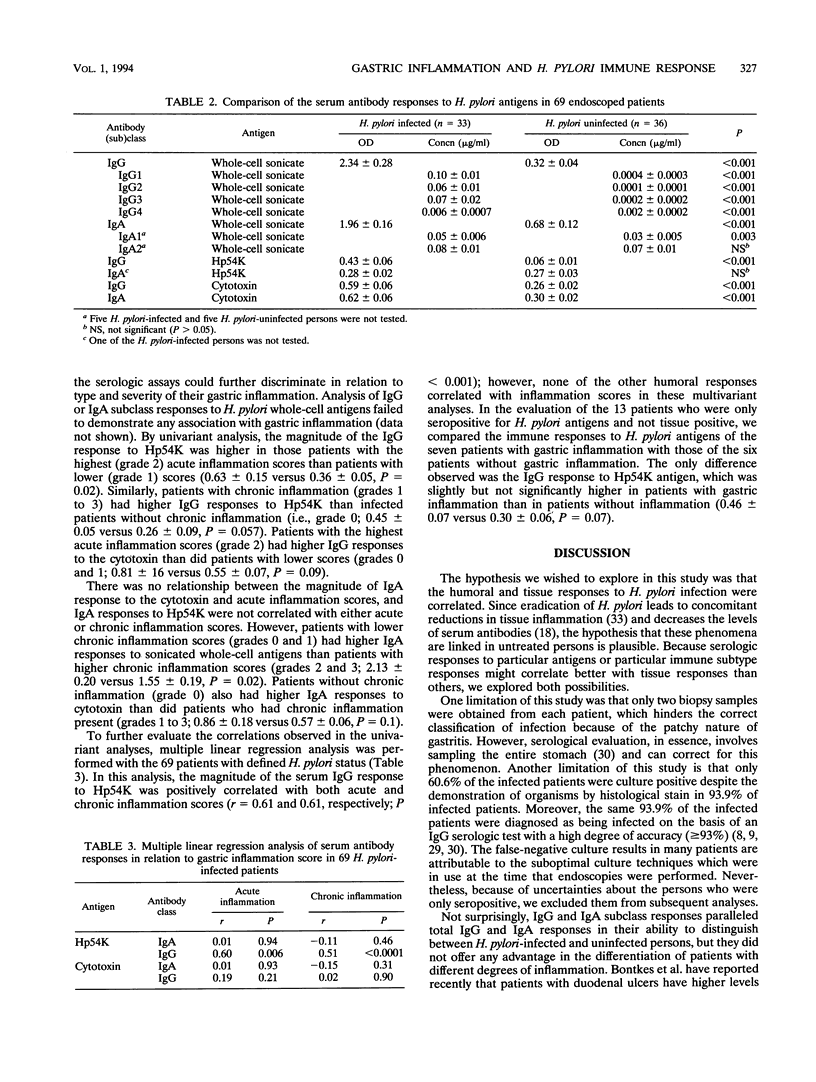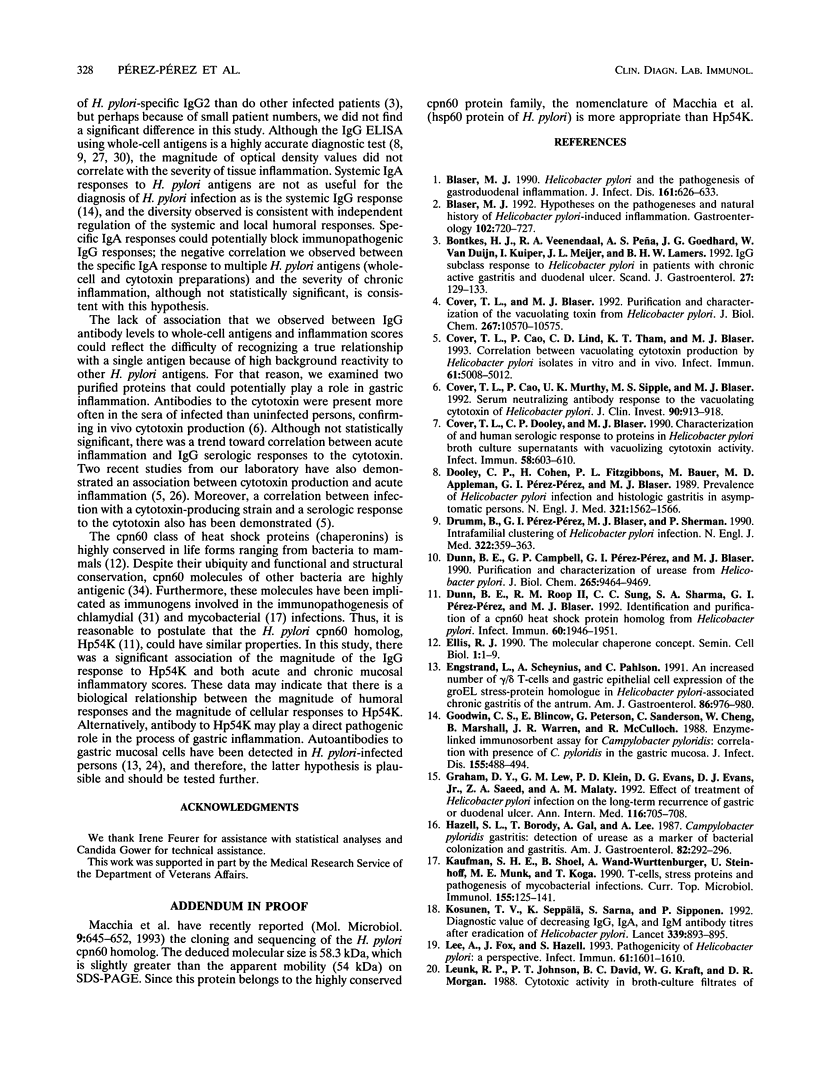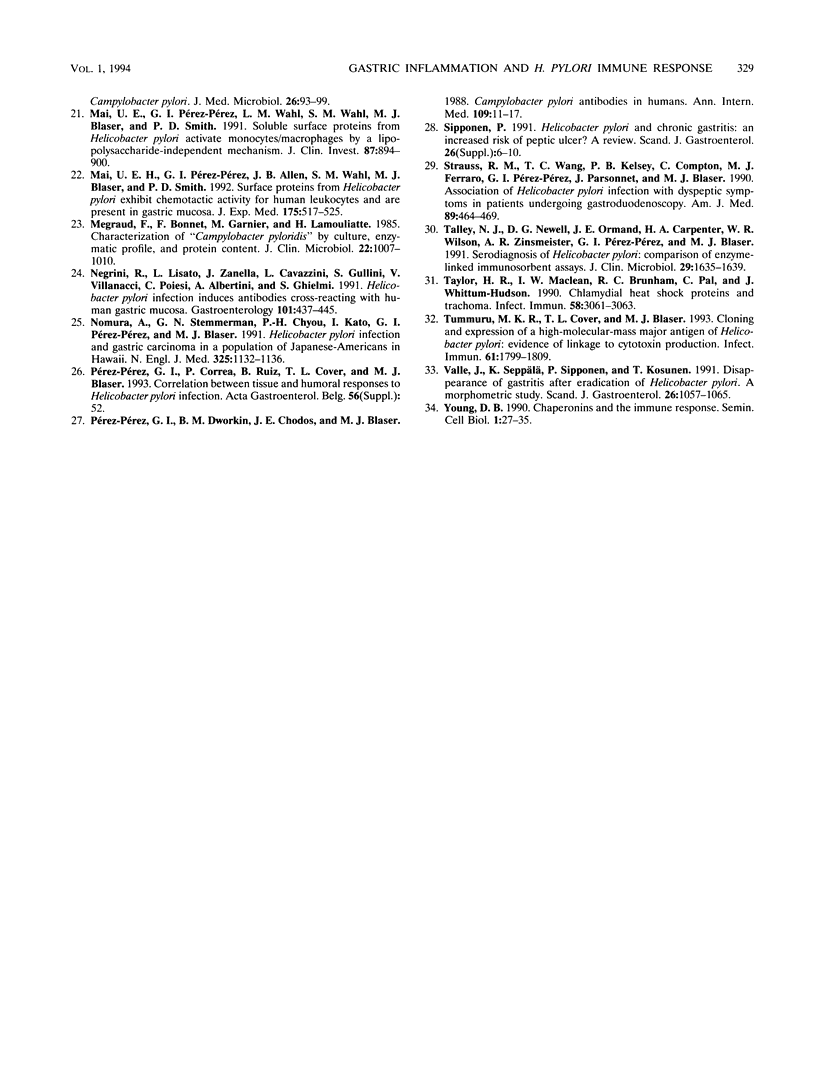Abstract
In 82 patients who underwent gastroduodenoscopy, acute and chronic gastric mucosal inflammation was scored for severity, and systemic humoral immune responses to Helicobacter pylori antigens were assessed by enzyme-linked immunosorbent assays. On the basis of culture, gastric histology, and serologic evaluation, 33 patients were classified as H. pylori infected and 36 were classified as uninfected. Thirteen patients had negative cultures and stains but were seropositive and were analyzed separately from the other two groups. Specific serum immunoglobulin G (IgG) subclass responses to H. pylori whole-cell antigens and specific IgG responses to the 54-kDa heat shock protein homolog (Hp54K) and vacuolating cytotoxin were significantly greater in infected than in uninfected patients as were specific IgA responses to whole-cell antigens and cytotoxin (P < 0.001). Among the H. pylori-infected persons, serum IgG responses to Hp54K and to the vacuolating cytotoxin were correlated with acute mucosal inflammatory scores. In contrast, serum IgA responses to whole-cell sonicate and to vacuolating cytotoxin were inversely related to chronic inflammatory scores. By multivariant regression analysis, only specific serum IgG responses to Hp54K correlated with severity of inflammation (both acute and chronic; P < 0.001); these responses may be markers of inflammation or these antibodies could play a direct role in the pathogenesis of H. pylori-induced inflammation.
Full text
PDF




Selected References
These references are in PubMed. This may not be the complete list of references from this article.
- Blaser M. J. Helicobacter pylori and the pathogenesis of gastroduodenal inflammation. J Infect Dis. 1990 Apr;161(4):626–633. doi: 10.1093/infdis/161.4.626. [DOI] [PubMed] [Google Scholar]
- Blaser M. J. Hypotheses on the pathogenesis and natural history of Helicobacter pylori-induced inflammation. Gastroenterology. 1992 Feb;102(2):720–727. doi: 10.1016/0016-5085(92)90126-j. [DOI] [PubMed] [Google Scholar]
- Bontkes H. J., Veenendaal R. A., Peña A. S., Goedhard J. G., van Duijn W., Kuiper J., Meijer J. L., Lamers C. B. IgG subclass response to Helicobacter pylori in patients with chronic active gastritis and duodenal ulcer. Scand J Gastroenterol. 1992;27(2):129–133. doi: 10.3109/00365529209165432. [DOI] [PubMed] [Google Scholar]
- Cover T. L., Blaser M. J. Purification and characterization of the vacuolating toxin from Helicobacter pylori. J Biol Chem. 1992 May 25;267(15):10570–10575. [PubMed] [Google Scholar]
- Cover T. L., Cao P., Lind C. D., Tham K. T., Blaser M. J. Correlation between vacuolating cytotoxin production by Helicobacter pylori isolates in vitro and in vivo. Infect Immun. 1993 Dec;61(12):5008–5012. doi: 10.1128/iai.61.12.5008-5012.1993. [DOI] [PMC free article] [PubMed] [Google Scholar]
- Cover T. L., Cao P., Murthy U. K., Sipple M. S., Blaser M. J. Serum neutralizing antibody response to the vacuolating cytotoxin of Helicobacter pylori. J Clin Invest. 1992 Sep;90(3):913–918. doi: 10.1172/JCI115967. [DOI] [PMC free article] [PubMed] [Google Scholar]
- Cover T. L., Dooley C. P., Blaser M. J. Characterization of and human serologic response to proteins in Helicobacter pylori broth culture supernatants with vacuolizing cytotoxin activity. Infect Immun. 1990 Mar;58(3):603–610. doi: 10.1128/iai.58.3.603-610.1990. [DOI] [PMC free article] [PubMed] [Google Scholar]
- Dooley C. P., Cohen H., Fitzgibbons P. L., Bauer M., Appleman M. D., Perez-Perez G. I., Blaser M. J. Prevalence of Helicobacter pylori infection and histologic gastritis in asymptomatic persons. N Engl J Med. 1989 Dec 7;321(23):1562–1566. doi: 10.1056/NEJM198912073212302. [DOI] [PubMed] [Google Scholar]
- Drumm B., Perez-Perez G. I., Blaser M. J., Sherman P. M. Intrafamilial clustering of Helicobacter pylori infection. N Engl J Med. 1990 Feb 8;322(6):359–363. doi: 10.1056/NEJM199002083220603. [DOI] [PubMed] [Google Scholar]
- Dunn B. E., Campbell G. P., Perez-Perez G. I., Blaser M. J. Purification and characterization of urease from Helicobacter pylori. J Biol Chem. 1990 Jun 5;265(16):9464–9469. [PubMed] [Google Scholar]
- Dunn B. E., Roop R. M., 2nd, Sung C. C., Sharma S. A., Perez-Perez G. I., Blaser M. J. Identification and purification of a cpn60 heat shock protein homolog from Helicobacter pylori. Infect Immun. 1992 May;60(5):1946–1951. doi: 10.1128/iai.60.5.1946-1951.1992. [DOI] [PMC free article] [PubMed] [Google Scholar]
- Ellis R. J. The molecular chaperone concept. Semin Cell Biol. 1990 Feb;1(1):1–9. [PubMed] [Google Scholar]
- Engstrand L., Scheynius A., Påhlson C. An increased number of gamma/delta T-cells and gastric epithelial cell expression of the groEL stress-protein homologue in Helicobacter pylori-associated chronic gastritis of the antrum. Am J Gastroenterol. 1991 Aug;86(8):976–980. [PubMed] [Google Scholar]
- Goodwin C. S., Blincow E., Peterson G., Sanderson C., Cheng W., Marshall B., Warren J. R., McCulloch R. Enzyme-linked immunosorbent assay for Campylobacter pyloridis: correlation with presence of C. pyloridis in the gastric mucosa. J Infect Dis. 1987 Mar;155(3):488–494. doi: 10.1093/infdis/155.3.488. [DOI] [PubMed] [Google Scholar]
- Graham D. Y., Lew G. M., Klein P. D., Evans D. G., Evans D. J., Jr, Saeed Z. A., Malaty H. M. Effect of treatment of Helicobacter pylori infection on the long-term recurrence of gastric or duodenal ulcer. A randomized, controlled study. Ann Intern Med. 1992 May 1;116(9):705–708. doi: 10.7326/0003-4819-116-9-705. [DOI] [PubMed] [Google Scholar]
- Hazell S. L., Borody T. J., Gal A., Lee A. Campylobacter pyloridis gastritis I: Detection of urease as a marker of bacterial colonization and gastritis. Am J Gastroenterol. 1987 Apr;82(4):292–296. [PubMed] [Google Scholar]
- Kaufmann S. H., Schoel B., Wand-Württenberger A., Steinhoff U., Munk M. E., Koga T. T-cells, stress proteins, and pathogenesis of mycobacterial infections. Curr Top Microbiol Immunol. 1990;155:125–141. doi: 10.1007/978-3-642-74983-4_9. [DOI] [PubMed] [Google Scholar]
- Kosunen T. U., Seppälä K., Sarna S., Sipponen P. Diagnostic value of decreasing IgG, IgA, and IgM antibody titres after eradication of Helicobacter pylori. Lancet. 1992 Apr 11;339(8798):893–895. doi: 10.1016/0140-6736(92)90929-w. [DOI] [PubMed] [Google Scholar]
- Lee A., Fox J., Hazell S. Pathogenicity of Helicobacter pylori: a perspective. Infect Immun. 1993 May;61(5):1601–1610. doi: 10.1128/iai.61.5.1601-1610.1993. [DOI] [PMC free article] [PubMed] [Google Scholar]
- Leunk R. D., Johnson P. T., David B. C., Kraft W. G., Morgan D. R. Cytotoxic activity in broth-culture filtrates of Campylobacter pylori. J Med Microbiol. 1988 Jun;26(2):93–99. doi: 10.1099/00222615-26-2-93. [DOI] [PubMed] [Google Scholar]
- Macchia G., Massone A., Burroni D., Covacci A., Censini S., Rappuoli R. The Hsp60 protein of Helicobacter pylori: structure and immune response in patients with gastroduodenal diseases. Mol Microbiol. 1993 Aug;9(3):645–652. doi: 10.1111/j.1365-2958.1993.tb01724.x. [DOI] [PubMed] [Google Scholar]
- Mai U. E., Perez-Perez G. I., Allen J. B., Wahl S. M., Blaser M. J., Smith P. D. Surface proteins from Helicobacter pylori exhibit chemotactic activity for human leukocytes and are present in gastric mucosa. J Exp Med. 1992 Feb 1;175(2):517–525. doi: 10.1084/jem.175.2.517. [DOI] [PMC free article] [PubMed] [Google Scholar]
- Mai U. E., Perez-Perez G. I., Wahl L. M., Wahl S. M., Blaser M. J., Smith P. D. Soluble surface proteins from Helicobacter pylori activate monocytes/macrophages by lipopolysaccharide-independent mechanism. J Clin Invest. 1991 Mar;87(3):894–900. doi: 10.1172/JCI115095. [DOI] [PMC free article] [PubMed] [Google Scholar]
- Megraud F., Bonnet F., Garnier M., Lamouliatte H. Characterization of "Campylobacter pyloridis" by culture, enzymatic profile, and protein content. J Clin Microbiol. 1985 Dec;22(6):1007–1010. doi: 10.1128/jcm.22.6.1007-1010.1985. [DOI] [PMC free article] [PubMed] [Google Scholar]
- Negrini R., Lisato L., Zanella I., Cavazzini L., Gullini S., Villanacci V., Poiesi C., Albertini A., Ghielmi S. Helicobacter pylori infection induces antibodies cross-reacting with human gastric mucosa. Gastroenterology. 1991 Aug;101(2):437–445. doi: 10.1016/0016-5085(91)90023-e. [DOI] [PubMed] [Google Scholar]
- Nomura A., Stemmermann G. N., Chyou P. H., Kato I., Perez-Perez G. I., Blaser M. J. Helicobacter pylori infection and gastric carcinoma among Japanese Americans in Hawaii. N Engl J Med. 1991 Oct 17;325(16):1132–1136. doi: 10.1056/NEJM199110173251604. [DOI] [PubMed] [Google Scholar]
- Perez-Perez G. I., Dworkin B. M., Chodos J. E., Blaser M. J. Campylobacter pylori antibodies in humans. Ann Intern Med. 1988 Jul 1;109(1):11–17. doi: 10.7326/0003-4819-109-1-11. [DOI] [PubMed] [Google Scholar]
- Sipponen P. Helicobacter pylori and chronic gastritis: an increased risk of peptic ulcer? A review. Scand J Gastroenterol Suppl. 1991;186:6–10. doi: 10.3109/00365529109103980. [DOI] [PubMed] [Google Scholar]
- Strauss R. M., Wang T. C., Kelsey P. B., Compton C. C., Ferraro M. J., Perez-Perez G., Parsonnet J., Blaser M. J. Association of Helicobacter pylori infection with dyspeptic symptoms in patients undergoing gastroduodenoscopy. Am J Med. 1990 Oct;89(4):464–469. doi: 10.1016/0002-9343(90)90377-p. [DOI] [PubMed] [Google Scholar]
- Talley N. J., Newell D. G., Ormand J. E., Carpenter H. A., Wilson W. R., Zinsmeister A. R., Perez-Perez G. I., Blaser M. J. Serodiagnosis of Helicobacter pylori: comparison of enzyme-linked immunosorbent assays. J Clin Microbiol. 1991 Aug;29(8):1635–1639. doi: 10.1128/jcm.29.8.1635-1639.1991. [DOI] [PMC free article] [PubMed] [Google Scholar]
- Taylor H. R., Maclean I. W., Brunham R. C., Pal S., Whittum-Hudson J. Chlamydial heat shock proteins and trachoma. Infect Immun. 1990 Sep;58(9):3061–3063. doi: 10.1128/iai.58.9.3061-3063.1990. [DOI] [PMC free article] [PubMed] [Google Scholar]
- Tummuru M. K., Cover T. L., Blaser M. J. Cloning and expression of a high-molecular-mass major antigen of Helicobacter pylori: evidence of linkage to cytotoxin production. Infect Immun. 1993 May;61(5):1799–1809. doi: 10.1128/iai.61.5.1799-1809.1993. [DOI] [PMC free article] [PubMed] [Google Scholar]
- Valle J., Seppälä K., Sipponen P., Kosunen T. Disappearance of gastritis after eradication of Helicobacter pylori. A morphometric study. Scand J Gastroenterol. 1991 Oct;26(10):1057–1065. doi: 10.3109/00365529109003956. [DOI] [PubMed] [Google Scholar]
- Young D. B. Chaperonins and the immune response. Semin Cell Biol. 1990 Feb;1(1):27–35. [PubMed] [Google Scholar]


